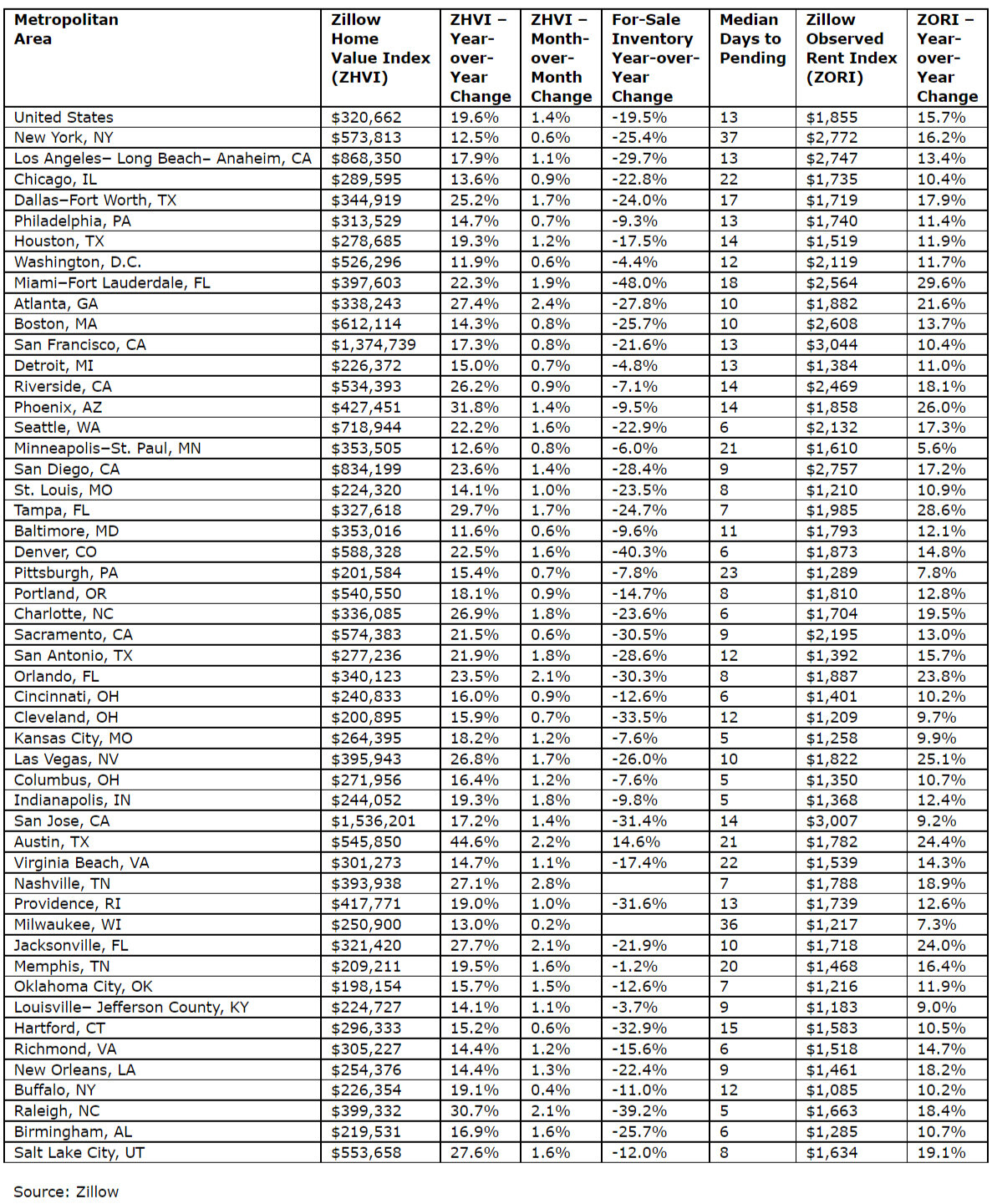Residential Real Estate News

Housing Inventory Down 40 Percent from pre-COVID Levels in U.S.
Residential News » Seattle Edition | By Michael Gerrity | January 25, 2022 9:02 AM ET
According to Zillow, the housing market appears to already be in full swing in 2022, as anxious buyers outnumbered dwindling new listings and drove inventory to record low levels in December 2021. Limited supply is already pushing price growth up, as Zillow's latest market report shows monthly home value appreciation accelerated for the first time since July 2021.
In addition to not wanting to wade into such a tight market as a buyer, homeowners could be hesitant to list their houses and move due to a resurgence in coronavirus cases and employers' rising uncertainty about post-pandemic working arrangements, according to a recent Zillow survey.
"Home shoppers picked the shelves clean this December, leaving fewer active listings than ever before in the U.S. housing market," said Jeff Tucker, senior economist at Zillow. "Enough determined buyers kept up their house hunt to reignite monthly price appreciation. Rising mortgage rates could be the next potential headwind, but demand has proven persistent; neither high prices nor slim inventories have deterred buyers so far."
The typical home value is now $320,662, 19.6% above that of December 2020. The annual growth rate represents an all-time high in data dating back more than 20 years. After decelerating since July, month-over-month home value appreciation reignited, jumping from 1.2% in November to 1.4% in December.
The resurgent upward pressure on prices is likely due to astonishingly low levels of inventory this winter. After slipping in November, inventory plunged in December, dropping 11.1% in a month to a new record low of about 923,000 homes. Buyers shopping in December had 19.5% fewer homes to choose from than they did a year before, when inventory was already at a record low. Compared to December 2019, there are now 40.5% fewer homes available for sale.
One bright point for buyers is that the speed of the market has gradually slowed since the frenzied summer. In June, the typical U.S. home spent just one week on the market before going under contract. That has risen every month since, to roughly 13 days in December. This is still an incredibly short time on the market, but those extra few days do give buyers more time to assess their options.
Surge in coronavirus cases could be hampering listings, plans to move
While December typically sees a sharp decline in newly listed inventory, the 18.9% monthly drop seen last month was the largest in the past three years. The rise of the omicron variant of coronavirus could be partially responsible, pushing homeowners to wait for infection rates to subside before listing.
Workers are also less certain about their long-term working arrangements, which could impact their plans to move. A December survey conducted by Zillow found that 52% of workers reported that their employer had announced post-pandemic work arrangements -- a lower share than was reported in June 2021. One possible explanation is that the rise of new coronavirus variants has caused employers to push back in-person start dates indefinitely.
Workers whose employer has announced post-pandemic work arrangements are more likely to say they are considering a move within the next three years: 51%, versus 41% for those whose employers have not lined out a plan.
Rent growth slows
Typical rents rose a record 15.7% year over year in December, to $1,855 per month. However, monthly growth was 0.7% in December, the lowest monthly growth seen since February.
Rents grew year over year in all 50 of the nation's largest metros. Annual rent appreciation was fastest across the Sunbelt, led by Miami (29.6%), Tampa (28.6%), Phoenix (26.0%) and Las Vegas (25.1%).
Sign Up Free | The WPJ Weekly Newsletter
Relevant real estate news.
Actionable market intelligence.
Right to your inbox every week.
Real Estate Listings Showcase
Related News Stories
Residential Real Estate Headlines
- Las Vegas Area Home Prices Uptick 4.3 Percent Annually in March
- Single-Family Rent Growth in U.S. Trends Upward in 2025
- U.S. Mortgage Rates Tick Down Post Trump Tariffs Commencement
- President Trump's 'Liberation Day' Tariffs Potential Impact on the U.S. Housing and Mortgage Markets
- Baby Boomers Biggest Cohort of U.S. Home Buyers in 2025 as Millennials Decline
- U.S. Monthly Housing Payments Hit Record High in 2025
- U.S. Pending Home Sales Uptick in February
- Global Prime Residential Rent Slowdown Continued in Late 2024
- Ireland Home Price Inflation Hits 8 Year High in Early 2025
- Existing Home Sales in America Uptick in February
- Great Miami Area Residential Sales Decline 15 Percent Annually in February
- Mortgage Rates Uptick in Mid-March, Ending 9-Week Decline in U.S.
- World Property Ventures Builds the Future of Real Estate with New Funding Round
- U.S. Builder Sentiment Declines Amid Economic Uncertainty and Rising Costs
- Black Homeownership Rates in U.S. Enjoy Largest Annual Increase of All Racial Groups
- Wealthy Renters Are Taking Over More of the U.S. Rental Market
- If U.S. Congress Does Not Extend NFIP Soon, Thousands of Daily Home Closings Impacted
- U.S. Mortgage Applications Spike 11 Percent in Early March
- Greater Palm Beach Area Residential Sales Rise in Early 2025
- New Apartments in U.S. Are Leasing at Slowest Pace on Record
- U.S. Mortgage Rates Drop to 4 Month Low in March
- Overall U.S. Mortgage Delinquency Rates Dip in December
- New Tariffs on Canada, Mexico to Impact U.S. Homebuilder Input Costs
- Monaco's Property Market: A Tale of Two Cities
- U.S. Home Purchase Cancellations Surge, 1 in 7 Sales Getting Canceled
- U.S. Pending Home Sales Hit Historic Low in Early 2025
- Greater Miami Area Residential Sales Dip in January
- Governor DeSantis Supports Ending Property Taxes in Florida
- WPV Aims to Become the Berkshire Hathaway of Real Estate Tech
- U.S. Home Sales Slump Continues in January
- Average Americans Spend 38 Percent of Monthly Income on Mortgage Payments
- Switzerland's Safe-Haven Appeal Grows with World's Wealthy Homebuyers
- U.S. Builder Confidence Rapidly Declines in February
- Las Vegas Home Sales Rise 6.7 Percent Annually in January, Condo Sales Dip
- Homebuyer Demand in America Drops to 5-Year Low in Early 2025
- Ownership More Affordable Than Renting in Most U.S. Markets
- The World's First Global Listings Service Launches, Called a GLS
- Home Prices Continue to Rise in 89 Percent of U.S. Metros in Late 2024
- Global Luxury Residential Prices Showed Gradual Improvement in Late 2024
- U.S. Construction Hiring Rate Drops to Lowest Levels in 5 Years






